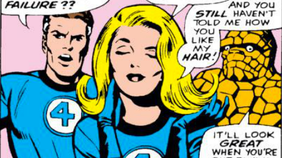Wonder Woman and Sailor Moon: Sexual Empowerment vs. Fanservice
- hannahlien
- Mar 10, 2015
- 3 min read
Reading the chapter “Wonder Woman: Bondage and Liberation” from Ben Saunders’ Do the Gods Wear Capes? made me think about whether or not Wonder Woman was the product simply of Marston’s own sexual fantasies or if she was the result of a genuine feminist sentiment. I think we can in part find an answer to this question by thinking of reactions to another prominent female hero in comics: Sailor Moon. Sailor Moon suffers from the same problems as Wonder Woman, that is many see her as simply a fanservice character for men and boys. (Fanservice being a character/outfit/situation designed to excite fans, sexually or otherwise). While boys may find enjoyment in both characters, I believe that they are intended to rather be fanservice to other women.

While Sailor Moon/Usagi is a character from a Japanese manga/anime, and in name not a superhero (technically part of the “magical girl” genre, but still rather super), I think that Sailor Moon is treated in much the same way that Wonder Woman is treated. Furthermore there are many commonalities between the two. Both present a female hero whose femininity is integral to her heroic identity. For Marston, Wonder Woman represented an intersection of love and power that he felt men were incapable of embodying. The main character of Sailor Moon, Usagi is a Sailor Senshi, or Guardian, and many of her powers emphasize or rely upon her femininity. Both series also give their leads a troop of other women to support them: Wondie gets Etta Candy and the Holiday girls; Sailor Moon gets the rest of the Sailor Senshi. Both are supported by a male love interest that often needs rescuing: Wonder Woman gets Steve Trevor, while Sailor Moon gets Tuxedo Mask. And perhaps the most important similarity between the two series lies in fan and critical reactions. Both characters celebrate feminine heroism, but many view them as pandering to a male audience.
Wonder Woman is portrayed taking part in light bondage play in the comics, which for Marston was clearly a source of fascination. Sailor Moon and her friends are portrayed in skimpy sailor-outfits, accompanied by semi-erotic transformation sequences. The eroticism exists in both series; it is inescapable, as Saunders points out in his essay. However, I don’t believe that this discounts the empowering natures of either character as well as the incredibly positive aspects of each work.

With an all-female team to back her up, Sailor Moon emphasizes female comradery in a manner that isn’t as clear in the early Wonder Woman comics. Each Sailor Senshi is given a distinct personality, while the Holiday Girls seem to be a sort of homogenous group with the exception of Etta Candy. However, Wonder Woman receives much more help from Etta Candy than she ever does from Steve Trevor. Wonder Woman is much more about female power and relationships than it is about male titillation. Referring to Gloria Steinem’s essay “Wonder Woman,” Wonder Woman faces many female villains, such as Doctor Poison or the Baroness, but also brings misguided women over to the side of goodness.

The only real issue is that Marston implies that being a good woman involves light bondage play, which seems designed to excite male readers. However, as Saunders points out, these Marston intends for female readers to also be excited: “theorists and critics thinking about Wonder Woman as a figure of lesbian identification is are not inappropriately or anachronistically projecting their own desires onto her; in fact they are probably responding precisely as her original creator hoped they would,” (DtGWC?, 60). Suggesting that characters like Wonder Woman and Sailor Moon as fanservice for men removes to possibility that they are intended to be fanservice for women and girls. Regarding the bondage scenes to not be solely targeted at men, just as one must remember that Sailor Moon aimed at young girls, the message of these scenes becomes twisted. Rather than emphasizing female vulnerability, Wonder Woman is portrayed in a way that is powerful and titillating for male and female viewers alike. There is a sexual charge in these comics, yes, but it is not unlike the sexuality that is present in Sailor Moon manga. It must be considered that the characters in these stories are shown taking control of their sexualities, not being controlled by others. Wonder Woman, nearly always has the ability of breaking out of her bonds, for example. After all, Marston asserts through the Amazons’ history with Hercules that being bound against one’s will is the worst fate of all.




















Comments